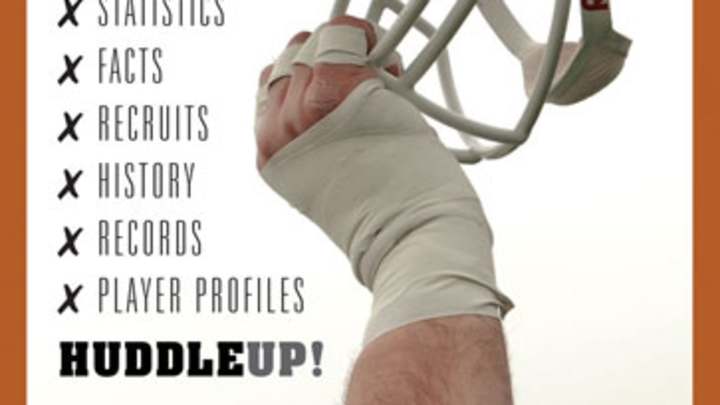Welcome to the Southeastern Conference, Texas!

The tradition dates back to Thanksgiving Day 1916, the final game of the football season and also when Robert Vinson became the new University of Texas president. Some 15,000 fans had packed the stands at Clark Field to watch the Longhorns (which was still an informal term and wouldn’t become the school’s official nickname for four more years) play rival A&M College of Texas, only to see the teams finish the first two quarters tied, 7-7.
During the break, a skinny and frightened longhorn steer was brought out on to the field and presented to the student body as the school’s first live mascot. The idea had been the brainchild of former team manager Stephen Pinckney, who had collected $1 from 124 other alumni to purchase the animal.
According to Jim Nicar, the Director of the UT Heritage Society, Pinckney had spent most of the year in West Texas working for the U.S. Attorney General’s office assisting with raids on cattle rustlers. During one such raid near Laredo in late September, he found a steer with orange fur that was almost an exact match for the school color. The longhorn was loaded onto a boxcar without food or water and arrived just in time for the game.
Texas went on to win, 21-7.
The steer was subsequently moved to a stockyard for a formal photograph, where it proved to be more ornery than the Aggies, and after the camera flash went off charged the photographer.
In the subsequent issue of the Texas Exes Alcalde magazine, editor Ben Dyer gave a full description of the day’s numerous events, and regarding the steer simply wrote: “His name is Bevo. Long may he reign!” (Note: The origin of the Bevo name is still very much in doubt).
While students debated about what to do with the wild animal, the Texan newspaper suggested branding the longhorn with a large “T” on one side and “22-7” on the other as a permanent reminder of the Texas victory. Instead, it prompted some A&M fans to break into the stockyard and brand Bevo with “13-0,” the score of the Aggies’ victory at College Station in 1915. A week later the longhorn was moved to a ranch 60 miles west of Austin, and mostly forgotten about during World War I.
After the 1919 season, with food a bit scarce and Bevo deemed not worth the money his care cost, the longhorn was barbequed and served at the January football banquet, with the Aggies invited and served the side they had branded.
Of course, something on that order would be almost unheard of today, although after the tradition was restored in 1936 the stories of the following mascots were just as colorful. Bevo II changed an SMU cheerleader and Bevo III broke loose and ran free on campus for two days. Bevo IV attacked a parked car, while Bevo V went after the entire Baylor marching band.
Nowadays, only champion steers are considered for the job and as of this writing Bevo XIV, originally named Sunrise Studly, was being tended to by the student group the Silver Spurs.
He’s 1,800 pounds of pure Texas pride, with horns measuring 72 inches, and just as much a UT tradition as Big Bertha, “The Eyes of Texas,” and the Hook ’Em Horns hand signal that arose in part from the mascot — and will get you in trouble in some European countries, where it means something completely different.
But as former student Walter Cronkite chimed in a series of commercials to promote a fund-raising effort in 1998, “We’re Texas.”
UNIVERSITY OF TEXAS
Location: Austin, Texas
Founded: 1881 (opened 1883)
Enrollment: 50,950 (40,804 undergrad)
Nickname: Longhorns
Colors: Burnt orange and white
Mascot: Bevo
Stadium: Darrell K Royal-Texas Memorial Stadium (100,119 capacity).
Webite: https://texassports.com
National Championships (4): 1963, 1969, 1970, 2005.
Conference Championships (28): 1920, 1928, 1930, 1942, 1943, 1945, 1950, 1952, 1953, 1959, 1961, 1962, 1963, 1968, 1969, 1970, 1971, 1972, 1973, 1975, 1977, 1983, 1990, 1994, 1995, 1996, 2005, 2009
Bowl appearances: 57 (31-24-2).
First season: 1893.
Parts of this post originated from the book, Huddle Up: Texas Football. This is the first story in a series that will examine the history of the Longhorns football program, and what it will bring to the SEC

Christopher Walsh is the founder and publisher of Alabama Crimson Tide On SI, which first published as BamaCentral in 2018, and is also the publisher of the Boston College, Missouri and Vanderbilt sites . He's covered the Crimson Tide since 2004 and is the author of 27 books including “100 Things Crimson Tide Fans Should Know and Do Before They Die” and “Nick Saban vs. College Football.” He's an eight-time honoree of Football Writers Association of America awards and three-time winner of the Herby Kirby Memorial Award, the Alabama Sports Writers Association’s highest writing honor for story of the year. In 2022, he was named one of the 50 Legends of the ASWA. Previous beats include the Green Bay Packers, Arizona Cardinals and Tampa Bay Buccaneers, along with Major League Baseball’s Arizona Diamondbacks. Originally from Minnesota and a graduate of the University of New Hampshire, he currently resides in Tuscaloosa.
Follow BamaCentral